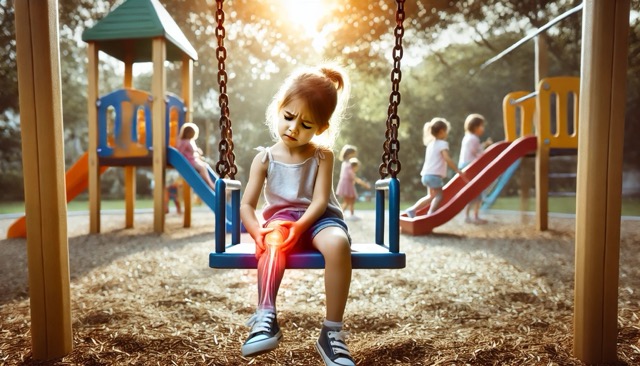Growing Pains or Ehlers-Danlos Syndrome: Rethinking Childhood Discomfort


For many generations, “growing pains” have been chalked up as a benign, if inconvenient, part of childhood. Most of us are familiar with the narrative: a child complains of achy legs or sore joints, especially at night. Parents are often reassured by doctors that this discomfort is a normal sign of growth spurts and should eventually disappear. However, a new wave of research and a growing awareness of connective tissue disorders have prompted many to ask: Could growing pains actually be a sign of something more serious, like Ehlers-Danlos Syndrome (EDS)?
This question is more than a casual curiosity. For parents of children who experience severe or prolonged pain, the “growing pains” diagnosis can feel inadequate and dismissive. With increasing recognition of the complex genetic condition known as Ehlers-Danlos Syndrome, it’s time to reconsider whether some of these unexplained pains in childhood are really just a normal part of development—or an indicator of an underlying condition.
What is Ehlers-Danlos Syndrome?
Ehlers-Danlos Syndrome (EDS) is a group of inherited disorders that primarily affect connective tissues—the structures in the body that support skin, bones, blood vessels, and other organs. EDS can vary in its presentation, but its hallmark symptoms include joint hypermobility, skin hyperextensibility (stretchy skin), and tissue fragility.
This disorder is classified into several subtypes, each characterized by different symptoms and degrees of severity. The most common subtype, hypermobile EDS (hEDS), often goes undiagnosed because its symptoms can overlap with other conditions, or are mistaken for simple “growing pains.”
The Overlap Between Growing Pains and EDS Symptoms
So, why the confusion between growing pains and Ehlers-Danlos Syndrome? To answer that, let’s first dive into the traditional understanding of growing pains. Growing pains typically involve:
- 🦵🏽 Intermittent pain in the legs, often around the thighs, calves, or behind the knees.
- 🌛 The pain tends to occur late in the day or at night.
- ⌛️ It often resolves on its own with time.
- 🙂 There’s usually no swelling, redness, or obvious injury.
This experience is familiar to many parents. However, for children with Ehlers-Danlos Syndrome, their joint and muscle pain can look quite similar—especially if they’re younger and can’t fully articulate their symptoms.
In children with EDS, joint hypermobility can lead to muscle fatigue, joint instability, and pain, particularly after physical activity. Some key similarities between EDS-related pain and growing pains include:
- 💥 Pain predominantly in the legs or joints.
- 🌚 Pain that worsens after activity or at night.
- 🚫 No obvious cause or injury.
However, there are some significant differences too, which we’ll explore shortly. The point here is that the similarity in symptoms makes it easy for healthcare providers to misattribute EDS pain to growing pains, especially if the child has not yet been diagnosed with a connective tissue disorder.
Key Differences Between Growing Pains and EDS Symptoms
While the overlap in symptoms can be confusing, there are key differences between growing pains and the signs of Ehlers-Danlos Syndrome. Recognizing these differences can lead to earlier diagnosis and treatment, preventing future complications for those with EDS.
😫 Chronicity and Severity of Pain: Growing pains tend to be episodic, lasting a few minutes to hours, and typically resolve on their own with time. Children with EDS, however, may experience more persistent, severe, or recurring pain that doesn’t follow the usual growing pains pattern.
🦵🏽 Joint Hyperextension: One of the hallmarks of EDS, especially the hypermobile subtype, is joint hypermobility—joints that extend beyond the normal range of motion. While most kids are flexible, children with EDS may be exceptionally so, often referred to as “double-jointed.” This hypermobility can lead to joint instability, frequent dislocations, and chronic pain, particularly in the knees, ankles, and hips.
🩹 Other Physical Signs: Children with EDS may have other subtle or not-so-subtle physical signs beyond pain. These can include:
- Soft or velvety skin that’s highly elastic.
- Easy bruising or skin that heals poorly, sometimes leaving thin, papery scars.
- Frequent sprains, strains, or joint dislocations, sometimes from very minor injuries.
- Fatigue, due to muscle overcompensation for weak joints.
😵💫 Autonomic Symptoms: Many children with EDS, particularly those with hypermobile EDS, experience autonomic dysfunction. This means that their autonomic nervous system, which controls things like heart rate, blood pressure, and digestion, may not function properly. Symptoms can include dizziness, fainting, gastrointestinal issues, and even difficulty regulating body temperature. Growing pains, by contrast, do not typically include these systemic symptoms.
Is the “Growing Pains” Diagnosis an Over-Simplification?
The growing pains diagnosis is often given to children without further exploration into the root causes of their pain. The problem with this blanket diagnosis is that it overlooks the possibility of underlying conditions, like Ehlers-Danlos Syndrome, that can be easily missed in young patients.
In a 2018 study published in Pediatric Rheumatology, researchers argued that the term “growing pains” is often applied without sufficient clinical investigation. They found that a significant number of children who were originally thought to have growing pains were later diagnosed with conditions like hypermobile EDS. This suggests that many children suffering from chronic musculoskeletal pain may be dismissed as having growing pains when they might actually benefit from further investigation and treatment.
The Impact of Misdiagnosis
A delayed or missed diagnosis of EDS can have serious consequences. Children with EDS who aren’t diagnosed early may continue to experience worsening pain, repeated joint injuries, and other health complications without appropriate intervention. For example:
- 💥 Joint damage: Without proper physical therapy or bracing, the chronic joint instability caused by EDS can lead to early-onset arthritis or long-term joint damage.
- ❤️🩹 Emotional toll: Chronic pain and repeated injuries, especially without a clear explanation, can lead to emotional distress, anxiety, or even depression. Children may feel as though no one believes them or that their pain is being dismissed.
- 😓 Reduced physical activity: Children with undiagnosed EDS may avoid physical activity due to pain, which can lead to poor muscle development and coordination, further exacerbating joint issues.
Early intervention, such as physical therapy designed for hypermobility, can make a significant difference in managing symptoms and preventing long-term complications.
How to Advocate for Your Child
If your child frequently complains of pain, especially joint or muscle pain, and you suspect it might be more than just growing pains, it’s important to advocate for them. Here are some steps to consider:
- 📔 Keep a pain diary: Track when and where the pain occurs, how long it lasts, and whether it’s associated with any particular activities. Does it happen at night? After physical exertion? Is there swelling or stiffness?
- 🩹 Watch for other signs: Look for signs of hypermobility, stretchy skin, or frequent injuries that seem disproportionate to the activity causing them.
- 👩🏻⚕️ Seek a specialist: If you’re concerned about EDS, request a referral to a pediatric rheumatologist, geneticist, or a specialist familiar with connective tissue disorders. Many primary care doctors may not be familiar with the subtleties of EDS and may dismiss your concerns.
- 🩼 Physical therapy: If EDS is suspected, working with a physical therapist who understands hypermobility is crucial. They can help your child strengthen the muscles around their joints, reducing the likelihood of injury and pain.
- 🧬 Genetic testing: While not always necessary, genetic testing can confirm some types of EDS, particularly the more severe forms. For hypermobile EDS, diagnosis is usually clinical, based on physical signs and symptoms.
Growing Awareness of EDS in the Medical Community
Fortunately, awareness of Ehlers-Danlos Syndrome is growing, and more healthcare providers are becoming familiar with its symptoms. Researchers are investigating how early signs of EDS can be detected and managed to improve quality of life for children affected by this condition.
One promising area of research focuses on how hypermobile EDS may be connected to other syndromes, such as POTS (postural orthostatic tachycardia syndrome) and MCAS (mast cell activation syndrome), both of which are more common in those with hypermobile EDS. This underscores the complexity of the condition and the importance of looking beyond “growing pains” when chronic pain is involved.
Conclusion: Growing Pains Deserve a Closer Look
It’s time to move away from the outdated notion that growing pains are a universal, harmless part of childhood development. For many children, chronic joint and muscle pain could be an indicator of Ehlers-Danlos Syndrome or another connective tissue disorder. Early recognition, diagnosis, and intervention can make a world of difference in managing symptoms and preventing long-term complications.
As parents, trusting your instincts and advocating for your child’s health is paramount. If growing pains persist, don’t be afraid to push for further investigation—because what might seem like routine discomfort could be the first clue in understanding a much larger and more complex picture.
- Pediatric Rheumatology Review of Growing Pains and Hypermobility Syndromes: Evans, A. M., & Scutter, S. D. (2004). Prevalence of ‘growing pains’ in young children. Journal of Pediatrics, 145(2), 255-261. DOI: 10.1016/j.jpeds.2004.03.037
- Ehlers-Danlos Syndrome Overview: Genetics Home Reference. (2019). Ehlers-Danlos Syndrome. National Library of Medicine. Available from: https://medlineplus.gov/genetics/condition/ehlers-danlos-syndrome/
- Exploring the Relationship Between Growing Pains and EDS: Tinkle, B., Levy, H., Symoens, S., et al. (2017). The 2017 International Classification of the Ehlers-Danlos Syndromes. American Journal of Medical Genetics, Part C: Seminars in Medical Genetics, 175C(1), 8-26. DOI: 10.1002/ajmg.c.31552
- Autonomic Dysfunction in Ehlers-Danlos Syndrome: Rowe, P. C., Barron, D. F., Calkins, H., et al. (1999). Orthostatic intolerance and chronic fatigue syndrome associated with Ehlers-Danlos Syndrome. Journal of Pediatrics, 135(4), 494-499. DOI: 10.1016/S0022-3476(99)70043-9
- Management of EDS in Children: Castori, M., Morlino, S., Pascolini, G., et al. (2015). Diagnosis and management of joint hypermobility syndrome (aka Ehlers-Danlos Syndrome, Hypermobility Type): An update for clinicians. American Journal of Medical Genetics Part C: Seminars in Medical Genetics, 169(1), 1-11. DOI: 10.1002/ajmg.c.31439





Responses